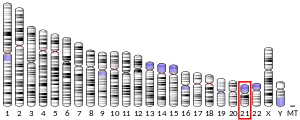B3GALT5
Beta-1,3-galactosyltransferase 5 is an enzyme that in humans is encoded by the B3GALT5 gene.[5][6]
| B3GALT5 | |||||||||||||||||||||||||||||||||||||||||||||||||||
|---|---|---|---|---|---|---|---|---|---|---|---|---|---|---|---|---|---|---|---|---|---|---|---|---|---|---|---|---|---|---|---|---|---|---|---|---|---|---|---|---|---|---|---|---|---|---|---|---|---|---|---|
| Identifiers | |||||||||||||||||||||||||||||||||||||||||||||||||||
| Aliases | B3GALT5, B3GalT-V, B3GalTx, B3T5, GLCT5, beta-1,3-GalTase 5, beta-3-Gx-T5, beta3Gal-T5, beta-1,3-galactosyltransferase 5 | ||||||||||||||||||||||||||||||||||||||||||||||||||
| External IDs | OMIM: 604066 MGI: 2136878 HomoloGene: 13230 GeneCards: B3GALT5 | ||||||||||||||||||||||||||||||||||||||||||||||||||
| |||||||||||||||||||||||||||||||||||||||||||||||||||
| |||||||||||||||||||||||||||||||||||||||||||||||||||
| |||||||||||||||||||||||||||||||||||||||||||||||||||
| |||||||||||||||||||||||||||||||||||||||||||||||||||
| |||||||||||||||||||||||||||||||||||||||||||||||||||
| Wikidata | |||||||||||||||||||||||||||||||||||||||||||||||||||
| |||||||||||||||||||||||||||||||||||||||||||||||||||
This gene is a member of the beta-1,3-galactosyltransferase (beta3GalT) gene family. This family encodes type II membrane-bound glycoproteins with diverse enzymatic functions using different donor substrates (UDP-galactose and UDP-N-acetylglucosamine) and different acceptor sugars (N-acetylglucosamine, galactose, N-acetylgalactosamine). The beta3GalT genes are distantly related to the Drosophila Brainiac gene and have the protein coding sequence contained in a single exon. The beta3GalT proteins also contain conserved sequences not found in the beta4GalT or alpha3GalT proteins. The carbohydrate chains synthesized by these enzymes are designated as type 1, whereas beta4GalT enzymes synthesize type 2 carbohydrate chains. The ratio of type 1:type 2 chains changes during embryogenesis. By sequence similarity, the beta3GalT genes fall into at least two groups: beta3GalT4 and 4 other beta3GalT genes (beta3GalT1-3, beta3GalT5). This gene encodes the most probable candidate for synthesis of the type 1 Lewis antigens which are frequently found to be elevated in gastrointestinal and pancreatic cancers. The encoded protein is inactive with N-linked glycoproteins and functions in mucin glycosylation. Five transcript variants have been described which differ in the 5' UTR. All transcript variants encode an identical protein.[6]
References
- GRCh38: Ensembl release 89: ENSG00000183778 - Ensembl, May 2017
- GRCm38: Ensembl release 89: ENSMUSG00000074892 - Ensembl, May 2017
- "Human PubMed Reference:". National Center for Biotechnology Information, U.S. National Library of Medicine.
- "Mouse PubMed Reference:". National Center for Biotechnology Information, U.S. National Library of Medicine.
- Isshiki S, Togayachi A, Kudo T, Nishihara S, Watanabe M, Kubota T, Kitajima M, Shiraishi N, Sasaki K, Andoh T, Narimatsu H (Jun 1999). "Cloning, expression, and characterization of a novel UDP-galactose:beta-N-acetylglucosamine beta1,3-galactosyltransferase (beta3Gal-T5) responsible for synthesis of type 1 chain in colorectal and pancreatic epithelia and tumor cells derived therefrom". J Biol Chem. 274 (18): 12499–507. doi:10.1074/jbc.274.18.12499. PMID 10212226.
- "Entrez Gene: B3GALT5 UDP-Gal:betaGlcNAc beta 1,3-galactosyltransferase, polypeptide 5".
Further reading
- Amado M, Almeida R, Schwientek T, Clausen H (2000). "Identification and characterization of large galactosyltransferase gene families: galactosyltransferases for all functions". Biochim. Biophys. Acta. 1473 (1): 35–53. doi:10.1016/S0304-4165(99)00168-3. PMID 10580128.
- Kalyanaraman VS, Rodriguez V, Veronese F, et al. (1990). "Characterization of the secreted, native gp120 and gp160 of the human immunodeficiency virus type 1". AIDS Res. Hum. Retroviruses. 6 (3): 371–80. doi:10.1089/aid.1990.6.371. PMID 2187500.
- Pal R, Hoke GM, Sarngadharan MG (1989). "Role of oligosaccharides in the processing and maturation of envelope glycoproteins of human immunodeficiency virus type 1". Proc. Natl. Acad. Sci. U.S.A. 86 (9): 3384–8. Bibcode:1989PNAS...86.3384P. doi:10.1073/pnas.86.9.3384. PMC 287137. PMID 2541446.
- Dewar RL, Vasudevachari MB, Natarajan V, Salzman NP (1989). "Biosynthesis and processing of human immunodeficiency virus type 1 envelope glycoproteins: effects of monensin on glycosylation and transport". J. Virol. 63 (6): 2452–6. doi:10.1128/jvi.63.6.2452-2456.1989. PMC 250699. PMID 2542563.
- Kozarsky K, Penman M, Basiripour L, et al. (1989). "Glycosylation and processing of the human immunodeficiency virus type 1 envelope protein". J. Acquir. Immune Defic. Syndr. 2 (2): 163–9. PMID 2649653.
- Robinson WE, Montefiori DC, Mitchell WM (1988). "Evidence that mannosyl residues are involved in human immunodeficiency virus type 1 (HIV-1) pathogenesis". AIDS Res. Hum. Retroviruses. 3 (3): 265–82. doi:10.1089/aid.1987.3.265. PMID 2829950.
- Zhou D, Berger EG, Hennet T (1999). "Molecular cloning of a human UDP-galactose:GlcNAcbeta1,3GalNAc beta1, 3 galactosyltransferase gene encoding an O-linked core3-elongation enzyme". Eur. J. Biochem. 263 (2): 571–6. doi:10.1046/j.1432-1327.1999.00541.x. PMID 10406968.
- Hattori M, Fujiyama A, Taylor TD, et al. (2000). "The DNA sequence of human chromosome 21". Nature. 405 (6784): 311–9. Bibcode:2000Natur.405..311H. doi:10.1038/35012518. PMID 10830953.
- Strausberg RL, Feingold EA, Grouse LH, et al. (2003). "Generation and initial analysis of more than 15,000 full-length human and mouse cDNA sequences". Proc. Natl. Acad. Sci. U.S.A. 99 (26): 16899–903. Bibcode:2002PNAS...9916899M. doi:10.1073/pnas.242603899. PMC 139241. PMID 12477932.
- Dunn CA, Medstrand P, Mager DL (2004). "An endogenous retroviral long terminal repeat is the dominant promoter for human β1,3-galactosyltransferase 5 in the colon". Proc. Natl. Acad. Sci. U.S.A. 100 (22): 12841–6. doi:10.1073/pnas.2134464100. PMC 240706. PMID 14534330.
- Sato T, Furukawa K (2004). "Transcriptional regulation of the human beta-1,4-galactosyltransferase V gene in cancer cells: essential role of transcription factor Sp1". J. Biol. Chem. 279 (38): 39574–83. doi:10.1074/jbc.M405805200. PMID 15263012.
- Gerhard DS, Wagner L, Feingold EA, et al. (2004). "The Status, Quality, and Expansion of the NIH Full-Length cDNA Project: The Mammalian Gene Collection (MGC)". Genome Res. 14 (10B): 2121–7. doi:10.1101/gr.2596504. PMC 528928. PMID 15489334.
- Dunn CA, van de Lagemaat LN, Baillie GJ, Mager DL (2006). "Endogenous retrovirus long terminal repeats as ready-to-use mobile promoters: the case of primate beta3GAL-T5". Gene. 364: 2–12. doi:10.1016/j.gene.2005.05.045. PMID 16112824.
- Hu YH, Warnatz HJ, Vanhecke D, et al. (2006). "Cell array-based intracellular localization screening reveals novel functional features of human chromosome 21 proteins". BMC Genomics. 7: 155. doi:10.1186/1471-2164-7-155. PMC 1526728. PMID 16780588.
External links
- B3GALT5 human gene location in the UCSC Genome Browser.
- B3GALT5 human gene details in the UCSC Genome Browser.




